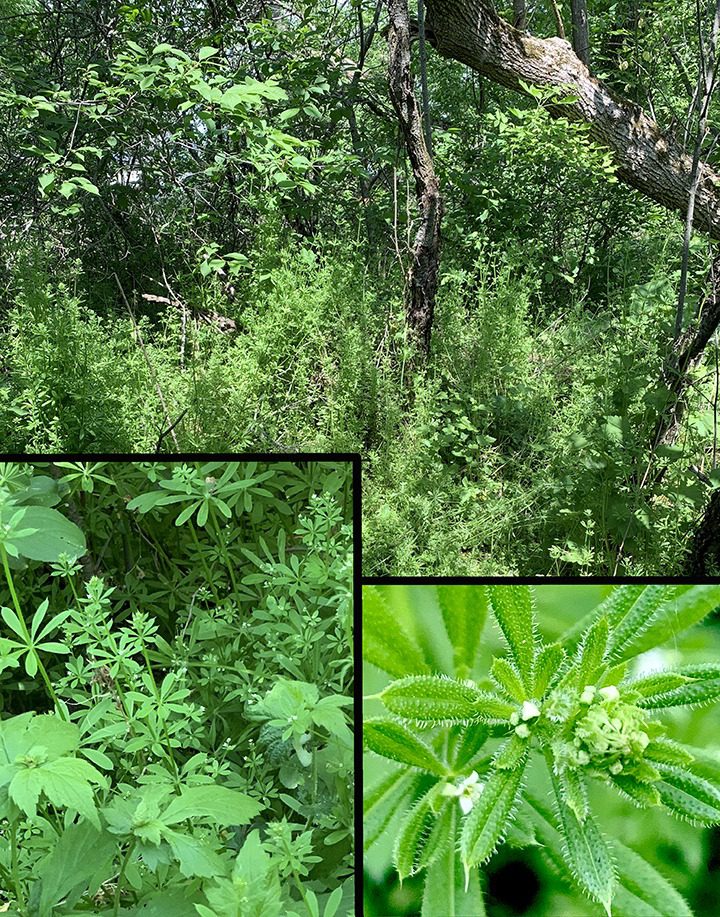Fred Schueler and Aleta Karstad, Fragile Inheritance Natural History
The genus Galium is called Bedstraw because, back before mattresses cost $750, they were stuffed with the stems and whorled leaves of these sprawling plants.
This year, our un-mowed shady spots have been overrun with a species of Bedstraw, which we’d tentatively called “Cleavers,” knowing that this was a prickly-stemmed Galium, and looking it up we found that we were using the right English name for the species Galium aparine. This has a long list of other English names, including Sticky-willy, Hitchhikers, Catchweed, Grip-grass, and Velcro-plant, and the minute hooked hairs on leaves, stems, and tiny burr-like fruit “cleave” onto anything that brushes by them, including socks and pant legs.

This is apparently a native species, found all across the Northern Hemisphere, but this spring it’s acting like an invasive around our homesite, clambering over Garlic Mustard and other invasives like a green surf, going a metre high up on fences and brushy areas, and dotting our clothes with little green burrs. Before a couple of years ago, we never noticed much Bedstraw here, and Cleavers is missing from the list of eastern Ontario vascular plants we inherited from the MNR back in the 1990s.
Wikipedia warns that while Cleavers is too prickly to eat raw, it can be cooked as a potherb. A quick experiment conducted during the composition of this article revealed a mild and pleasant flavour, along with a tremendous amount of prickly fibre. Wikipedia also says that while exposure to Cleavers may cause “an unpleasant localized rash” in some individuals, poultices and teas of the plant can be used to treat “a variety of skin ailments, light wounds, burns, poisonous bites, and stings.”
I asked around by e-mail and facebook about the status of Cleavers, and got a variety of responses: Kristl Walek in Brockville hadn’t seen any, Valerie Kirkwood in Actons Corners has “lots and lots of Bedstraw, but none of it is the prickly kind,” Douglas Thompson in the Richmond/North Gower area says Bedstraw “has been on the ascendancy for the past couple of years. I do not see any prickles,” Stew Hamill in Wolford Centre “first identified Galium aparine in 2001 but haven’t seen any large increase lately,” Matt Keevil on Craig Road noticed Bedstraw “seemingly increasing at my place too. We have had the clinging species in the past, which was probably seeded by birdseed, but the species we have in abundance now tangles feet but doesn’t stick.”
Across southern Ontario, some field-botanist respondents had seen increases in Cleavers, and others had other Bedstraws. Carla Carlson has Cleavers in Vineland Station: “For about 5 years it’s been horrific in our sandy loam. Everywhere on all the properties and down the hill to the Twenty Mile Creek. Covers all our gardens, all our flowers. And never had it before that to speak of.”
We suspect that this year’s long cool spring may have encouraged both the Cleavers and other Bedstraws. Galium is a huge genus (about 650 species), with many species that are hard to identify, and many spread around by human activity. Matt Keevil went after his “tangles feet but doesn’t stick” species and “tentatively reached an identification of Galium mollugo that iNaturalist.ca calls Hedge Bedstraw and Go Botany calls Whorled Bedstraw.
The other possible ID is Galium album (White Bedstraw). There’s only a handful of flowers open so far and the last couplet depends on them, so it may be a bit early to be sure. Apparently both species are introduced to North America” (see https://inaturalist.ca/observations/81626634).
Another introduced species is Yellow Bedstraw, Galium verum, which Wasyl Bakowsky recalled as “dominating old fields in Richmond Hill (houses now of course) around 1990, and now becoming more frequent in every direction,” and which we’ve recorded as matting down roadsides along the Dwyer Hill Road.
If anyone has stories of increasing or decreasing Cleavers, wants us to try to identify photos of Bedstraws, or just wants to complain how hard it is to get the little green burrs off their socks, they can write to us at bckcdb@istar.ca.





